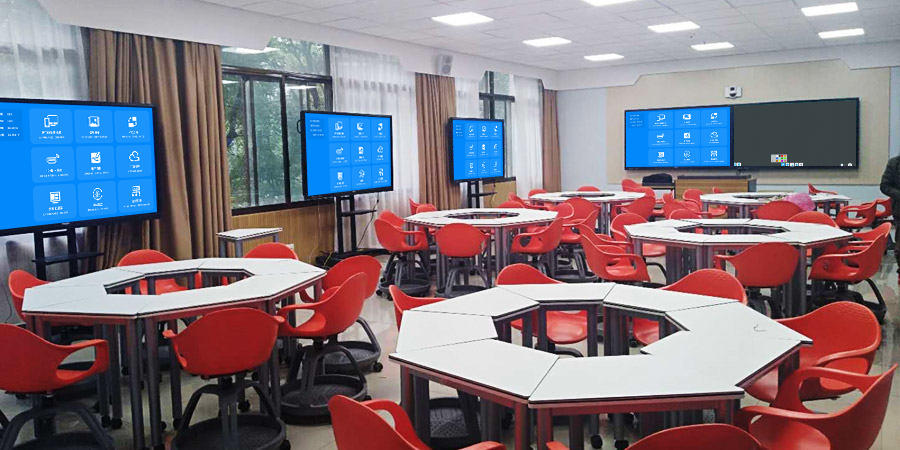Multi-Screen Interaction: Cross-Device Collaboration Solution
The multi-screen interaction solution breaks down the barriers between mobile phones, computers, tablets, and large screens, enabling seamless content flow and complementary functional linkage. It meets the needs of scenarios such as office collaboration, teaching interaction, and home entertainment without complex operations, making information transmission more efficient and interaction more flexible.
Full Device Compatibility, Zero Connection Barrier
It covers Android/iOS mobile phones, Windows/macOS computers, tablets, and various smart large screens. Both new and old devices, as well as products from different brands, can be smoothly adapted. Flexible and diverse connection methods are available:
- Wireless Mode: Complete connection within 3 seconds via system-native functions (e.g., mobile phone “Wireless Projection”, computer “Projection”, Apple “Screen Mirroring”) or QR code pairing, with no need to install any apps.
- Wired Mode: Supports plug-and-play for interfaces such as HDMI and Type-C, allowing easy access even for old devices.
Devices automatically recognize and match each other, with no need to distinguish between models or system versions. The adaptation rate exceeds 95%, truly achieving “full-terminal interconnection”.
Core Interaction Functions, Empowering Multiple Scenarios
1. Free Cross-Screen Content Flow
Supports “one-to-many”, “many-to-one”, and “two-way mutual transmission”:
- Office Scenarios: A computer can cast a plan to the meeting large screen while synchronizing it to colleagues’ tablets for annotation.
- Home Entertainment Scenarios: Photos taken on a mobile phone can be batch-cast to the TV, and videos playing on the large screen can also be saved to the mobile phone with one click.
- Teaching Scenarios: Teachers can cast courseware to the main screen, and students’ tablets receive the content synchronously for review after class.
Content transmission requires no USB drives or file transfer tools as intermediaries—it can be completed by dragging, dropping, or tapping, eliminating the hassle of repeated exporting and importing.
2. Complementary Multi-Screen Functional Linkage
- Extended Screen Collaboration: Set a tablet as a “second screen” for a computer—write reports on the computer while searching for information on the tablet; or use a mobile phone as a “remote control” for the large screen to adjust playback progress and switch content while lying down.
- Cross-Screen Control Interconnection: Use a computer mouse to control a mobile phone for replying to messages and organizing files, avoiding frequent device switching; teachers can use a tablet stylus to circle and annotate cast courseware, with traces synchronously displayed on the large screen for more flexible operation.
3. Multi-Terminal Synchronous Annotation
During meeting discussions or classroom interactions, multiple people can annotate the same document on different devices. Red pens marking key points and text comments are synchronously displayed on all screens in real time, making the collision of ideas more intuitive. Annotated results can be saved and shared with one click.

In-Depth Adaptation to Multiple Scenarios, Dual Improvement of Efficiency and Experience
1. Office Collaboration Scenarios
When a team works on a project, members divide tasks across devices: one person builds the PPT framework on a computer, another takes on-site material photos with a mobile phone, and a third designs illustrations on a tablet. All content is summarized on the large screen in real time, keeping everyone updated on progress. During remote meetings, mobile phones cast on-site images, computers cast plan details, and large screens integrate and display the content. Remote colleagues can provide feedback via tablet annotations, enabling distance-free collaboration and increasing decision-making efficiency by 40%.
2. Teaching Interaction Scenarios
Teachers explain theoretical knowledge on a computer while a tablet synchronously plays experimental operation videos; the large screen integrates both types of content, helping students understand more thoroughly. During group discussions, each group organizes ideas on a tablet and casts the results to the public large screen for class-wide review. Students can take photos of their questions with mobile phones and cast them to the large screen, and teachers explain on the spot—making classroom interaction more active and knowledge transfer more efficient.
3. Home Entertainment Scenarios
On weekends at home, cast movies or TV shows from a mobile phone to the TV, while the tablet synchronously displays a bullet chat interaction interface for the whole family to watch and chat together. When accompanying children to study, cast educational animations to the TV and use a mobile phone to remotely control pausing and explaining. When gathering with relatives and friends, multiple people take turns casting games or short videos from their mobile phones to the TV—no more crowding around small screens, making shared fun more enjoyable.
Intelligent Management, Secure and Hassle-Free
Administrators can set device interaction permissions through the backend, specifying which devices can share content and whether cross-screen control is allowed to avoid irrelevant interference. It supports “device whitelists” and “temporary authorization codes”—external devices can only access after authorization, ensuring content privacy.
Devices can be used once connected to the network, with no complex wiring required. The backend enables real-time monitoring of operating status, remote troubleshooting, and firmware updates, resulting in zero burden for daily maintenance.
Whether for enterprise offices, school teaching, or home use, this multi-screen interaction solution can accurately meet needs, giving full play to the advantages of each device and realizing the collaborative value of “1+1>2”.
